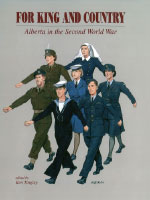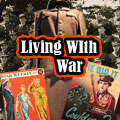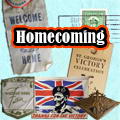Every Kitchen is an Arsenal
Catherine C. Cole
Reprinted with permission of the author and publisher of For King and Country: Alberta in the Second World War Women made many significant contributions to Canada's war effort. In Alberta, at least five hundred women entered the armed forces. Mary Dover of Calgary was a Lieutenant Colonel in the Canadian Women's Army Corps [CWAC], and headed the country's largest training centre. The Alberta Women's Service Corps [AWSC] was established at the beginning of the war to train women in military discipline, first aid, transport, clerical, commissariat, and other duties. Women formed auxiliary units to the Veterans Volunteer Reserve and participated in activities such as rifle practice, first aid training, social events and fundraising. In addition to their military and paramilitary efforts, women on the home front contributed voluntary service through agencies such as the Women's Institutes [WI], the United Farm Women of Alberta [UFWA], the Red Cross, the Imperial Order of the Daughters of the Empire [IODE], the Young Women's Christian Association [YWCA], and various church groups. Some women also started non-affiliated groups with the single purpose of contributing to the war effort.
Women made many significant contributions to Canada's war effort. In Alberta, at least five hundred women entered the armed forces. Mary Dover of Calgary was a Lieutenant Colonel in the Canadian Women's Army Corps [CWAC], and headed the country's largest training centre. The Alberta Women's Service Corps [AWSC] was established at the beginning of the war to train women in military discipline, first aid, transport, clerical, commissariat, and other duties. Women formed auxiliary units to the Veterans Volunteer Reserve and participated in activities such as rifle practice, first aid training, social events and fundraising. In addition to their military and paramilitary efforts, women on the home front contributed voluntary service through agencies such as the Women's Institutes [WI], the United Farm Women of Alberta [UFWA], the Red Cross, the Imperial Order of the Daughters of the Empire [IODE], the Young Women's Christian Association [YWCA], and various church groups. Some women also started non-affiliated groups with the single purpose of contributing to the war effort.
A national census undertaken late in 1939 registered women for Emergency Services, and they trained for opportunities which might arise during the war. These women worked in wartime industries such as the Great Western Garment Company and Aircraft Repair Ltd. in Edmonton, and filled men's traditional roles teaching, in local businesses, and on the farms. Between 1940 and 1942 the number of male family members working on farms across the nation dropped by 13.2 per cent and the number of male hired hands dropped by over 40 per cent.1 No matter what type of war-work women were engaged in, all the while they thought about their husbands, fiancés, sons or daughters serving overseas, and worked to make their time more bearable, and towards a shortened war.
Women's Wartime Concerns
The outbreak of war brought an abrupt end to the Great Depression. It provided an abrupt change of focus for women, from money and security anxieties, to fear for loved ones and uncertainty for the future. Women's pages of newspapers continued to relate fashion tips and information about health, nutrition, child care, weddings, the comings and goings of society's elite and other social events, but many articles had a new focus. Serialized novels had wartime titles such as "Girl at the Front" and "So Your Husband's Gone to War". Most of the organized social events reported were now fundraisers in one form or another, or efforts to entertain servicemen stationed in the region, or their wives and mothers. The daily lives of women changed as well. One of the first changes noted on the home front was that marriage became more popular; 200 more couples married in 1939 than in 1938, an increase of about 50 per month since the outbreak of war. The records office noted that the "[majority] of the would-be grooms told office clerks that they wanted to get married before joining the army so that their wives would be able to get allowances".2 As the war progressed, many aspects of their lives were regulated by government, and women felt more and more demands upon their time and their emotions. Newspapers were critical of the federal government's response to the war, writing that Canada seemed slow to respond to the emergency. Women's voluntary service organizations, on the other hand, already were experienced in war-work from the First World War, and immediately mobilized their members, who began knitting, fundraising, and providing a broad range of comforts for soldiers. Women initiated numerous means to assist the war effort, and were always anxious to support broader societal efforts, but an editorial in the Edmonton Journal titled "Why Ignore the Women?" questioned the lack of recognition of women's contributions by Ottawa.
The women of Canada are just as anxious to help their men smash Hitlerand all his works as are the women of the British Isles to help their men.In Britain, the government has organized its eager women to assist inalmost every phase of their country's war effort. In Canada, the governmentdoes not seem to know or care that the women can and want to help.3
As the years passed, and more and more men were called into active service, the abilities and contributions of women become more important. Each year saw women coping with additional responsibilities. Many women were left on their own to raise their children and handle family finances, in many cases for the first time. Women, as the primary purchasers in families, were encouraged to buy British and Empire-made goods to assist the economies of the allies. They were urged to save their spare change to buy war savings stamps, and were responsible for both the buying and the selling of war savings stamps. Aluminum salvaging began in the summer of 1941, and salvage of fats began in 1942. "Every Kitchen is an Arsenal" was a slogan in the campaign to collect fats and bones, and posters and leaflets proclaimed that "If everyone in Canada saves as little as two ounces of waste cooking fat in a week, it will produce the glycerine required for the gunpowder to smash Adolph, Benito and Tojo!"4 Edmonton children were given a free theatre ticket for every two pounds of fat collected, and women in the Citizens Volunteer Bureau coordinated the campaign. Rural areas also participated in the salvage programmes and forwarded their salvage to central depots; grain elevators doubled as collection depots throughout the rural west. Rationing began in February 1942, with sugar limited to 3/4 pound per person per week. Within months, tea, coffee and butter also were rationed, effectively ending the popular "Afternoon Tea" fundraisers. The following year, the rationing was extended to include meats other than fish and poultry, preserves and alternative sweeteners.
While many of the changes in women's lives were viewed as temporary, or "for the duration", early in the war women recognized that many changes would be permanent. Encouraging increased settlement in the west had long been seen as desirable, and one aspect of women's club work had traditionally been to welcome new settlers to an area and assist them in adapting to the Canadian way of life. These women faced difficult questions during the war. For many, the war was being fought to support democracy, a British democracy. And many women's groups felt that all people who chose to live in Canada had an obligation to support the cause. For example, the UFWA voted to revoke an agreement giving Hutterites and their descendants the privilege of not fighting when Canada was at war because they "felt that at a time of crisis there should be no group with special privileges".5 Friction between groups was acknowledged as a problem. Mrs. Harvey Agnew of Toronto stressed to a meeting of the YWCA the importance of home front activity, and "referring to the quarrels between Canadians and Immigrants said women should take a share in unifying the various peoples of Canada".6 The IODE was one of many organizations which from the first days of the war addressed the concern of a pending refugee problem. Provincial President Mrs. R.C. Marshall stated that "Canada's wide open spaces will inevitably give us a refugee or immigration problem. In the past we have shouldered some duties in connection with Canadianization. We must decide what we will do for immigrants in
Notes
1. Fort Record, 23 September 1942.
2. Edmonton Journal, 2 January 1940.
3. Edmonton Journal, 16 January 1941.
4. Advertisement in the Fort Record, 10 March 1942.
5. Edmonton Journal, 22 January 1940.
6. Edmonton Journal, 1 June 1940.








